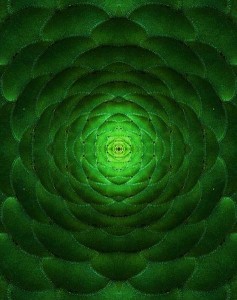Following my post on dhyana last week, I thought I would expand this into a discussion of mysticism. Mysticism is a phenomenon that has been misunderstood and treated with prejudice on many sides – particularly by scientific naturalists and by traditional Protestants, who often seem to use it as a pejorative term. For these people, ‘mysticism’ often seems to mean something like ‘supernaturalist obscurity’. Presumably they see mystics as cloaked dogmatists who confuse the issues through too much emphasis on ambiguity. For me, however, the term ‘mystic’ is overwhelmingly positive. Mystics are the heroes who have stood out against dogma and continually laid the emphasis on genuine experience in all the world’s religious traditions.
Mysticism begins with dhyana-like sublime experience, a type of experience available to anyone and not at all tied to religious beliefs of any kind. Here is an example from the autobiography of Jane Goodall (the chimpanzee expert), ‘Reason for Hope’:
Many years ago, in the spring of 1974, I visited the cathedral of Notre Dame in Paris. There were not many people around, and it was quiet and still inside. I gazed in silent awe at the great Rose Window, glowing in the morning sun. All at once the cathedral
was filled with a huge volume of sound: an organ playing magnificently for a
wedding taking place in a distant corner. Bach’s Tocata and Fugue in D Minor. I
had always loved the opening theme; but in the cathedral, filling the entire
vastness, it seemed to enter and possess my whole self. It was at though the
music itself was alive. That moment, a suddenly captured moment of eternity,
was perhaps the closest I have ever come to experiencing ecstasy, the ecstasy
of the mystic.
This is a modern example, but experiences like this have been recorded across cultures and religions. In Hinduism and Buddhism mystical experience is actively cultivated in meditation and is part of the mainstream tradition. In Islam it is an important part of the Sufi tradition, and in Christianity you can read the experiences of a succession of mystics such as Hildegard of Bingen, Richard Rolle and Jacob Boehme.
like this have been recorded across cultures and religions. In Hinduism and Buddhism mystical experience is actively cultivated in meditation and is part of the mainstream tradition. In Islam it is an important part of the Sufi tradition, and in Christianity you can read the experiences of a succession of mystics such as Hildegard of Bingen, Richard Rolle and Jacob Boehme.
What these people had in common was that, having experienced temporary integrated states, they could see beyond the rigidities of metaphysical belief. Often this put them into conflict with the metaphysical mainstream of their religions (for example, the persecution of Sufis has been a regular feature of fundamentalist phases in Islam). More often, however, mystics have been happy to pay lip-service to the metaphysical pieties that surrounded them, whilst actually being largely indifferent to metaphysics. At the same time they have earned a far more profound respect from those who experienced their genuine degree of integration, and the wisdom and compassion that flowed from that.
Mystical experience is sometimes treated as a subset of religious experience, or sometimes identified with religious experience as a whole. I am more inclined to the former, as there are many types of experience that can be called ‘religious’. Some other forms of religious experience are also recorded by mystics – particularly visions. Visions, however, like dhyana-type experiences, can be recognised as powerful and valuable experiences without being attached to metaphysical beliefs. The significance of a vision can be implicitly or explicitly recognised as archetypal rather than conveying representational truths-out-there.
Of course, mystics in the theistic religions have often talked about God. However, for them God seems to have been an experience of uncertainty rather than the dogmatic basis of certainty that assertions about God and his revelations seem to have been for others. Where they express apparent certainty, it usually turns out to be a recognition of how far their lives had been changed by mystical experience, rather than any assertion about propositional ‘truths’ behind that experience. Where mystics have written about their experiences, they have often used language that may appear vague. They were writing, after all, about the cloud of unknowing (the title of a fourteenth century English mystical text of anonymous authorship), so their degree of vagueness was entirely appropriate to their subject matter. When it comes to advice on mystical practice, on the other hand, they are quite capable of precision. It is those who write about uncertain matters with a misleading amount of precision that we should be more suspicious of than of the mystics.
The mystical traditions of the world offer a huge resource of inspiration for the practice of the Middle Way. Of course, past and present mystics are each limited in their assumptions by their historical and religious circumstances. They can also be one-sided because their openness is so much concentrated towards the emotive end of the spectrum of meaning, so that they are not very likely to show deep critical thought or an investigative attitude to the world. Nevertheless, the mystics have absorbed and kept alive an important element of the spirit of agnostic scepticism through the ages, and we can still benefit from that spirit today.

